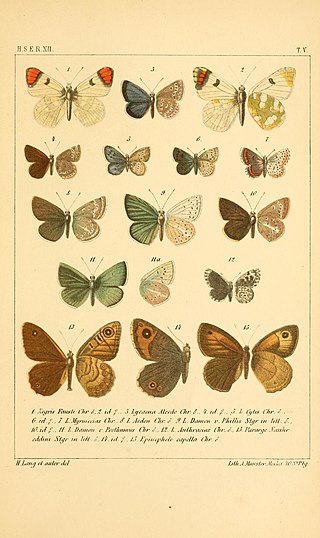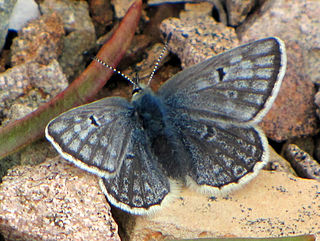
The Tian Shan, also known as the Tengri Tagh or Tengir-Too, meaning the "Mountains of God/Heaven", is a large system of mountain ranges in Central Asia. The highest peak in the Tian Shan is Jengish Chokusu, at 7,439 metres (24,406 ft) high. Its lowest point is the Turpan Depression, which is 154 m (505 ft) below sea level.

Polyommatus eros, the Eros blue or common meadow blue, is a species of blue butterfly found in the Palearctic.

Plebejus is a genus of butterflies in the family Lycaenidae. Its species are found in the Palearctic and Nearctic realms.

Boloria is a brush-footed butterfly (Nymphalidae) genus. Clossiana is usually included with it nowadays, though some authors still consider it distinct and it seems to warrant recognition as a subgenus at least.

Athamanthia is an Eastern Palearctic genus of butterfly in the family Lycaenidae. Athamanthia is differentiated from Lycaena by characters of the male genitalia.

Agriades orbitulus, the alpine argus, is a butterfly of the family Lycaenidae. It is a high altitude species found in the Alps, the mountains of Norway and Sweden, the Urals, the Himalayas and across central Asia.

Turanana is a genus of butterflies in the family Lycaenidae. It is found in the east Palearctic from Greece to Central Asia.

Cupido is a genus of butterflies in the family Lycaenidae. The subgenus Everes is included here.

Muschampia is a Palearctic genus of spread-winged skippers in the family Hesperiidae.

Agriades glandon, the Arctic blue or Glandon blue, is a species of butterfly in the family Lycaenidae. It in found in Eurasia and North America.

The Pamir-Alay is a mountain system in Tajikistan, Kyrgyzstan and Uzbekistan, encompassing four main mountain ranges extending west from the Tian Shan Mountains, and located north of the main range of Pamir. They are variously considered part of the Tian Shan, of the Pamir, or a separate mountain system. The term "Pamiro-Alay" is also used to refer to the mountain region encompassing the Pamir, the Pamir-Alay proper and the Tajik Depression.

Hemaris ducalis, the Pamir bee hawkmoth, is a moth of the family Sphingidae. It is known from the mountains of south-western Xinjiang in China, the western Tian Shan, southern and eastern Kazakhstan up to the Altai Mountains, western Mongolia, southern Uzbekistan, Kyrgyzstan, Tajikistan, northern Afghanistan and Pakistan.

Melitaea solona is a butterfly of the family Nymphalidae. It is found in the Tian Shan mountains, Tibet, Alai and Trans-Alay regions.

Spialia orbifer, the orbed red-underwing skipper or Hungarian skipper is a butterfly of the family Hesperiidae. It is found from south-eastern Europe and temperate Asia to Korea. The habitat consists of steppe on plains and grassy slopes in the mountains.
Polygonia undina is a butterfly of the family Nymphalidae first described by Grigory Grum-Grshimailo in 1890. It is found from Ghissar-Darvaz to the Pamirs-Alai and Tian-Shan in north-western China and the Himalayas.

Polygonia interposita is a butterfly of the family Nymphalidae. It is found from Ghissar to the Altai Mountains, north-western China, the Himalayas and Mongolia. The habitat consists of gorges and slopes up to 2,500 meters above sea level.

Hyponephele is a genus of butterflies of the subfamily Satyrinae in the family Nymphalidae. Most range from Europe into central Asia with a few in northern Africa. They are commonly called meadowbrowns.

Afarsia is a Palearctic genus of butterflies in the family Lycaenidae.It has been synonymized with Albulina by some authors, but studies on the molecular phylogenetics of Polyommatini have led to its treatment as an independent genus, which appears as the sister group of the genus Kretania sensu lato, with weak support.

















